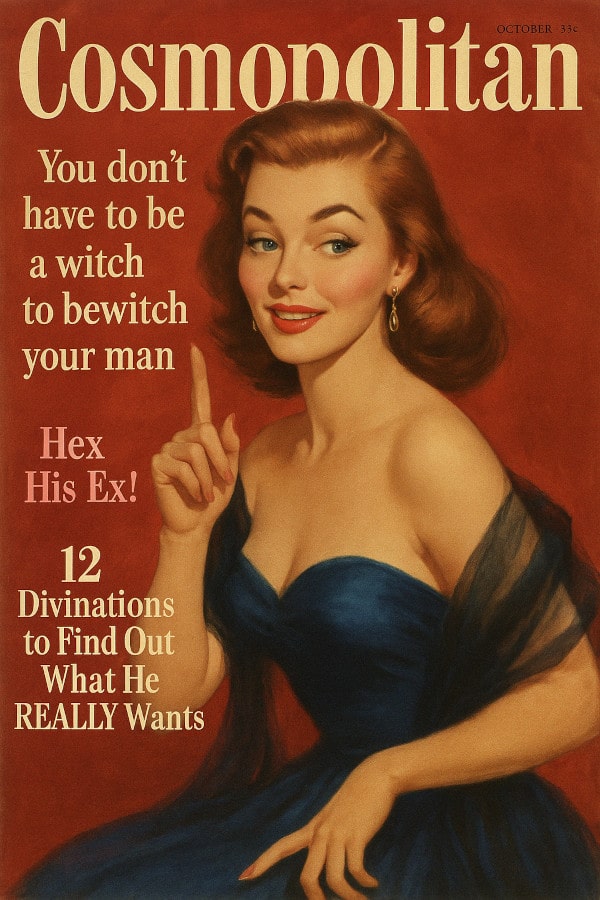"Used to be you only heard about the Veil in campfire stories and confession booths. Now they’re bottlin' it, patentin' it, sellin' it like toothpaste. And folks wonder why the world's crackin' at the seams."By the early 1950s, the Veil is no longer some whispered superstition or secret weapon of the elite — it’s a fact of life, like it or not. Walk through any major city and you’ll find traces of it: minor Veil-charmed trinkets promising good luck, protective glyphs built into skyscraper foundations, patent medicines touting "resonance-stabilized vitality formulas." Most people know better than to dabble deeply — if they dabble at all — but a little bit of the Veil is just another part of modern life, like electricity, penicillin, or nuclear power. Consumer products infused with minor Veil touches seem tame by comparison: Jewelry designed to ward off illness or misfortune. Construction materials laced with stabilizing glyphs for structural endurance. Clothing stitched with Veil-infused fibers said to resist wear, fire, or even small injuries. Pharmaceuticals offering faster healing through carefully moderated resonance. Of course, only licensed corporations — operating under heavy government scrutiny — are allowed to market these goods. Anything stronger than a mild charm steps into dangerous, highly illegal territory. Even those small enchantments are so costly that the final products are priced well out of reach for most.
Stigma, Fear, and Resentment
By the mid-20th century, attitudes toward the Veil are shifting — slowly, unevenly, and not without resistance. Some of it is fueled by capitalism’s endless hunger to bottle and sell the unsellable. Some of it is just the spirit of the times: kids questioning their parents, musicians breaking tradition, women demanding new roles. Humanity is reaching for the stars, dreaming of computers, and tampering with forces it barely understands. Accepting the Veil — or pretending to — fits right into that restlessness. But make no mistake: fear still lingers. Especially among the old guard. Minor charms and Veil-infused consumer goods are tolerated — sometimes even celebrated. But those who study or manipulate the Veil directly? They're seen as dangerous... or worse, tainted. At the mill, the old-timers grumble about the "improvements" management keeps rolling out — convinced something’s going to blow up and take a dozen men with it. The term "Veil-touched" carries a heavy weight, whispered about academics, federal agents, and war veterans who came home a little too strange. Parents warn their children: "Don’t talk to the charm-men. Don’t go near the glyph houses." Preachers rail from pulpits, condemning Veil practices as sorcery or blasphemy. And yet, even the faithful sometimes slip into back alleys when the need grows desperate enough — looking for a blessing, a healing, or a curse they can’t get anywhere else.Veil in Movies, Comics, and Journalism
As society grows more comfortable with the idea of the Veil, pop culture moves to cash in. The Veil has long haunted classic literature, but by the booming youth-driven culture of the 1950s, it is becoming woven into the fun of pulp fiction, matinee thrillers, and comic book racks. MoviesVeil horror films grow more popular every year — The Mist Beyond (1948), The Crimson Sigil (1950), Whisperers in the Wall (1952). Westerns feature Veil-tainted outlaws — "slingers" who carve glyphs into their revolvers. Noir thrillers depict battered detectives battling black market Veil smugglers across neon-lit backstreets. Comics
Pulp heroes like The Warden defend cities from Veil corruption. Villains like "The Riftmaster" plot to collapse Chicago into another plane. A few kid-friendly comics even glamorize Veil magic — sparking protests from churches and schools. Journalism
Newspapers scream sensational headlines: "Suburban Family Vanishes After Summoning Gone Wrong!" Exposés on illegal Veil labs and corporate coverups fill Sunday editions. Fearmongering editorials ask: "Is Your Neighbor a Summoner?" — echoing Red Scare paranoia.
Famous Veil Figures: Heroes, Villains, and Cautionary Tales
Major HeroesCaptain Charles "Steel" McKenna - Decorated WWII veteran who led a platoon against Veil-tainted Axis forces at Normandy. Sister Maria del Rosario - Catholic nun who helped seal a resonance rift over southern Mexico during the Depression using forbidden glyphs and ancient prayers. Infamous Figures
Dr. Alastair Greaves - Cambridge scholar who vanished after opening an unauthorized portal in the Scottish Highlands; rumor says he "never really closed the door." The East End Pact Club - London aristocrats who bargained for immortality during WWI — and whose descendants remain... different. Cautionary Tales
Lillian "Lucky Lil" Hawkins - Black market charm-slinger who won her fortune and lost her mind inside a cursed Chicago speakeasy. Father Emmett Yarrow - Pastor who led a Veil-banishment revival in Oklahoma — and accidentally triggered a Bleed Zone that swallowed three towns whole.




Comments